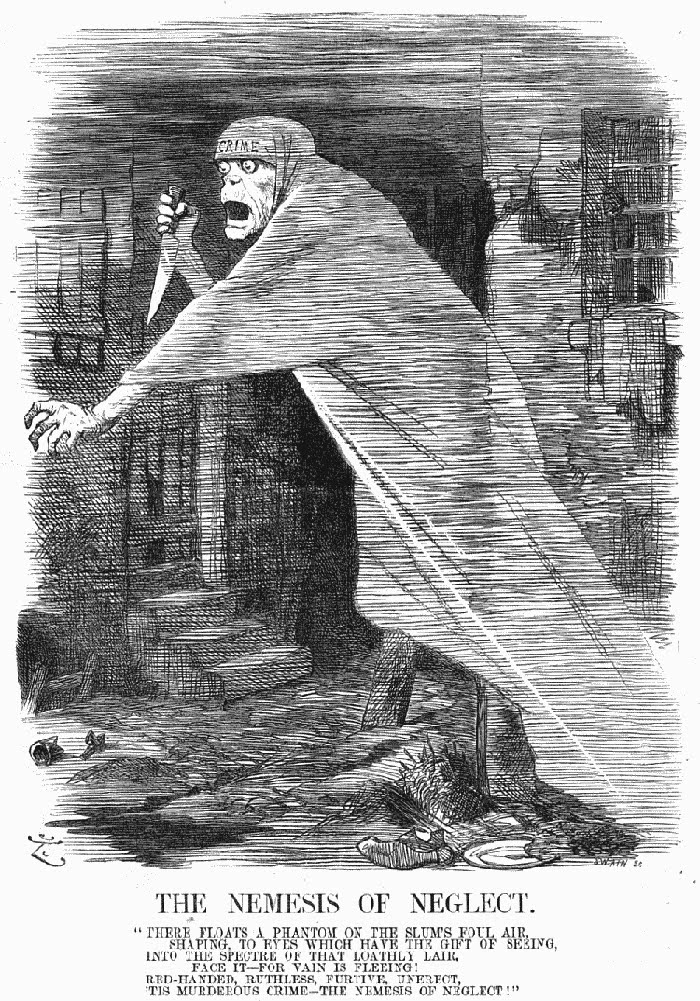
There were some curious and sad stories from the police courts on 30 August 1864.
At Bow Street a man was sent for trial for stealing his landlady’s shawl (value £1) but the circumstances were most peculiar.
She had found him drunk in her room, sitting on one chair with his feet up on another. When she asked him to leave he dropped to all fours and started barking like a dog and meowing like a cat. A policeman gave evidence that just days before the same man had been seen trying to persuade soldiers in uniform to desert to join ‘the Federals’ (meaning the Northern ‘Union’ army fighting the American Civil War against the Southern ‘Confederates’).
At Worship Street Maurice Lawrence cut a sad figure in the dock. Described as ‘a general dealer’ who lived on Plumbers Row, Whitechapel, he was clearly down on his luck. He struggled to stand on his one good leg, the other was ‘withered’ and ‘about to be amputated’ the court was told.
He had been discovered by Michael Mahon, allegedly stealing flowers from Victoria Park. Mahon was an old soldier – a sergeant major who’d seen service in the Crimean War – and he caught Lawrence plucking ‘three dahlias and two geraniums’ and, in his new position as park constable, arrested him. As he was bring led away to the station house Lawrence begged to be set free, offering Mahon 5s for his liberty.
In court he admitted taking the flowers but denied attempting to bribe the park constable, and then threw himself on the mercy of the magistrate. He rolled up his trousers to reveal his withered limb ‘which was seen to be no thicker than an ordinary walking stick’.
If he hoped the magistrate would let him off he was disappointed. The magistrate declared that unless people that stole flowers were punished ‘the beds will very speedily be destroyed’.
‘You are manifestly in a state of suffering’, he said, ‘but I am not certain that this should be taken into consideration’.
So for stealing a small bunch of flowers from a public park Maurice Lawrence was fined a shilling and the cost of the flowers. Since he was unable or unwilling to pay this he was sent to prison for a day instead. Perhaps that represented leniency, but it seems a fairly unkind punishment for a man that was so obviously in a state of extreme poor health.
The last story that caught my eye (leaving aside a man that tried to kill himself with a dose of laudanum) was that of two landlords prosecuted for keeping unlicensed lodging houses. Both prosecutions were at Greenwich Police court before Mr Traill, the sitting justice. John Buckley (in absentia) and Johanna Keefe were both accused of renting rooms (although the term is hardly apt, ‘space’ would be more accurate) without a license.
The cases were brought by Sergeant Pearson (45A) the inspector of lodging houses in the district’. He testified to visiting both properties (in Mill Lane) and describing the scene he found there.
At Buckley’s he found a room with:
‘with beds, each occupied by a two men, three of whom paid 4d a night each, and the other 2s a week; and in a cupboard in the same room he found a bed on the floor occupied by two men, each paying 1d a night. The size of the cupboard, which had neither light nor ventilation, was about 6 feet in length, by 4 feet in width and 5 feet high’.
There were other rooms with similarly cramped lodgings within them. At Johanna Keefe’s he found a room that had:
‘three beds, each occupied by two men, five of whom paid 2s per week each, the sixth being the defendant’s son’.
‘What!’, interjected Mr Traill, ‘Ten shillings a week rent for one room?’
‘Yes, your worship’, the sergeant replied, ‘and a small room, not being more than 12 feet square’.
The magistrate issued a warrant for Buckley’s arrest (he had form for this offence) and fined Keefe 20s. Hearing that she had eight years worth of previous convictions he warned her that if she persisted in taking lodgers without obtaining a license he would start fining her 20 shillings a day.
All in all the day’s reports made a fairly depressing read and reminded Londoners that their city had plenty of social problems in the mid 1860s.
[from Morning Post Tuesday 30 August 1864]








